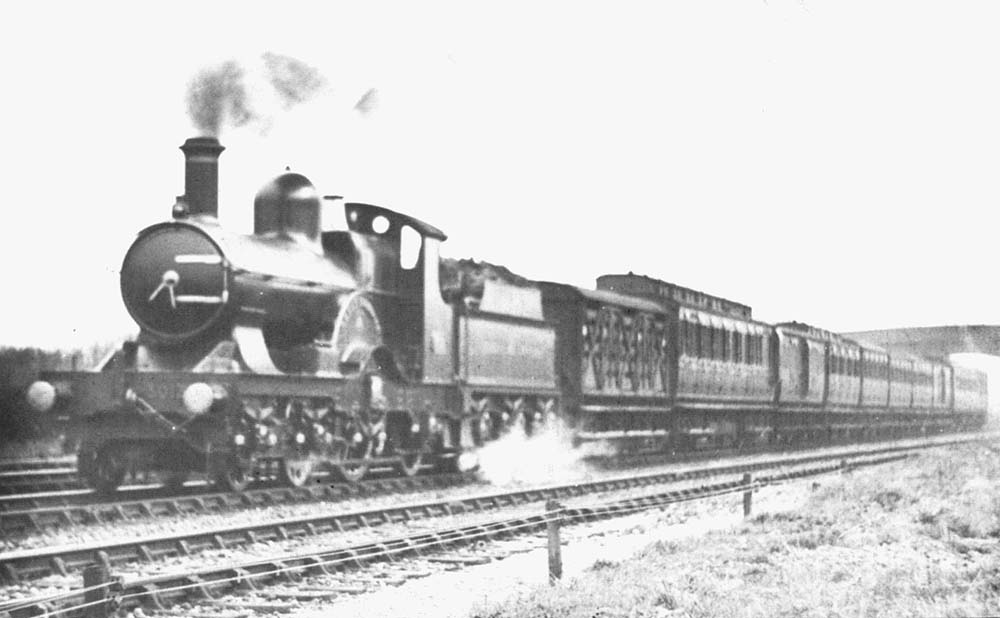 |
|
GWR Route: Banbury to Wolverhampton
Knowle & Dorridge Station: gwrkd1623
 |
Great Western Railway 4-2-2 Dean Single 'Achilles' class No
3013 'Great Britain' on the 3:28 pm down local from Knowle & Dorridge to
Birmingham on Wednesday 9th April 1913. There were four lines between Knowle
& Dorridge Station and Bentley Heath Level Crossing; the main lines in the
centre and a relief loop line on either side. In the foreground the signal
wires can be clearly seen. These are supported by 4 foot long 3 by 3 inch
timber stakes spaced 8 to 10 yards apart, which are rigidly fixed in the
ground. The signal wires pass through a pulley on each stake to maintain
separation between the wires. If the signal wires are allowed to rub, their
galvanised coating can be damaged, exposing the inner steel wire which could
then corrode and fail. No 3013 was built at Swindon Works in March 1892 as a
double framed 2-2-2 as part of Lot No 84. These had a 7 foot 8.5 inches
diameter single driving wheel and 4 foot 7 inch leading and trailing wheels.
With an 11.5 foot long, parallel boiler the locomotive there was too much
forward weight resulting in the locomotive being unsteady at speed. After No
3021 had a serious derailment in Box Tunnel in December 1892, it was decided to
rebuild the whole class with a 4-2-2 wheel arrangement. The frames of No 3013
were lengthened in November 1894 and a front bogie added. At the same time the
diameter of the cylinders was reduced to 19 inch. In November 1906, No 3013 was
rebuilt with a standard No 2, 11 foot long, domeless, parallel boiler with a
belpaire firebox and drumhead smokebox (type D0), while in October 1910 a large
domed parallel boiler with a raised belpaire firebox and drumhead smokebox
(type BR5) was fitted and the boiler pressure raised from 160 lbs to 180 lbs.
The limited space between the two driving wheels prevented the standard No 2
coned boiler being fitted.
It was at this point that No 3013 received the tall thin
chimney seen in the photograph. These locomotives were built for the West
Country expresses, but with the increased train weights they were superseded on
this traffic by 4-4-0 locomotives and redeployed to lighter express duties. In
1900 a larger turntable was installed at Stafford Road Shed in Wolverhampton
allowing these locomotives to operate expresses to Birmingham and
Wolverhampton, but by 1908 their limited power and the introduction of 4-6-0
locomotives meant that they were relegated to secondary duties. No 3013 was
withdrawn in February 1914 and the entire class had gone by the end of the
following year. The first vehicle in the train is a six wheeled milk van,
probably to diagram O3. These vans were 27.5 foot long with two double doors on
each side, 8 foot wide and 6 foot 8 inches tall. The sides had wide spaced
planking to maximise the ventilation and they had a six ton capacity, which was
later increased to 10 tons. Three lots were built between 1893 and 1895
totalling 100 vans. They were designed to carry milk churns (or other
perishables) in passenger trains, so had automatic vacuum brakes and from 1904
were painted brown with yellow lettering to distinguish them from normal goods
wagons which were painted grey. Milk vans had the telegraphic name
‘Siphon’ and between 1905 and 1907 steam pipes were added to allow
these vans to be marshalled anywhere in the train. After the milk van, the
first carriage is a clerestory, short brake, composite coach. It has a lookout
for the guard at the rear end and has seven compartments, but is unlikely to
have a corridor.
Robert Ferris
 back back

|
